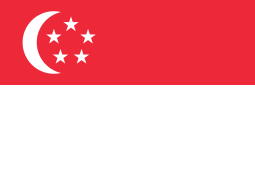Flag of Singapore
 | |
| Use | National flag |
|---|---|
| Proportion | 2:3 |
| Adopted | 3 December 1959, as the flag of State of Singapore |
The Flag of Singapore consists of two horizontal halves—red above white. Red symbolises universal brotherhood and equality of man; white stands for pervading and everlasting purity and virtue. In the upper left corner, a white crescent moon and five white stars form a circle. The five stars stand for the ideals of democracy, peace, progress, justice, and equality.[1]
For 140 years (1819-1959), the Union Jack flew over Singapore. Then, on 3 December 1959, the National Flag was unveiled at the installation of the new Head of State, the Yang di-Pertuan Negara, when Singapore was granted self-rule (but not complete independence) by the British Government. Also unveiled that day were the State Crest and the National Anthem. The flag was conceived and created by a committee headed by then Deputy Prime Minister Dr. Toh Chin Chye.
Gallery

 Standard of the President of Singapore flag. Flag ratio: 1:2
Standard of the President of Singapore flag. Flag ratio: 1:2
 Civil ensign. Flag ratio: 1:2
Civil ensign. Flag ratio: 1:2
 Government ensign. Flag ratio: 1:2
Government ensign. Flag ratio: 1:2
 Naval ensign. Flag ratio: 1:2
Naval ensign. Flag ratio: 1:2
Guidelines for Usage
Guidelines for the use of the flag have been relaxed in recent years to encourage greater usage.
How it may be used
Singaporeans and non-governmental buildings may display or fly the national flag to identify with the nation. Singaporeans are encouraged to do this during occasions of national celebration or national significance.
How it should be used
- When the flag is displayed outside a building, it shall be displayed on or in front of the building. Outside the National Day celebrations period (month of August), it must be flown only from a flagpole, and if it is displayed or flown at night, it should be properly illuminated.
- Within Singapore, it should take precedence over all other flags, subject to international practice. When displayed or flown with another flag, it must be in a position of honour. This means it should be positioned where practicable, either above all other flags or to the left of the other flags, as seen by a person facing the flags.
- It may be reproduced in reduced size representations and displayed at all times, but it must be in its true form and colours, regardless of size.
How it cannot be used or treated
- The flag cannot be used:
- in any trademark or for any commercial purpose;
- as a means, or for the purposes, of advertisement;
- as, or as part of, any furnishings, decoration, covering or receptacle;
- at any private funeral activity;
- incorporated or worn as part of any costume or attire; or
- on any private vehicle.
- No person shall produce or display any flag which bears any graphics or word superimposed on the design of the flag.
- The flag should be cleaned when dirty, and replaced if it has faded. After any washing, it should not be hung out to dry outdoors together with other laundry. Any worn out or damaged flag should be properly disposed of, not left visible in dustbins. Torn or worn-out flags should be packed into a sealed black trash bag before being disposed of.
References
- ↑ ), National Geographic Society (U.S (1918). "The Flags of the British Empire". National Geographic Magazine. 32. National Geographic Society: 383. Retrieved 12 January 2009.
Related pages
- Coat of arms of Singapore
- Majulah Singapura - the National Anthem of Singapore
- Singapore National Pledge
- Vanda Miss Joaquim - the National Flower of Singapore
- Symbol of Singapore - the Lion Head symbol
Other websites
- The Singapore Infomap - Information on the Singapore Flag Archived 2006-06-20 at the Wayback Machine
- National Heritage Board Archived 2003-06-13 at the Wayback Machine